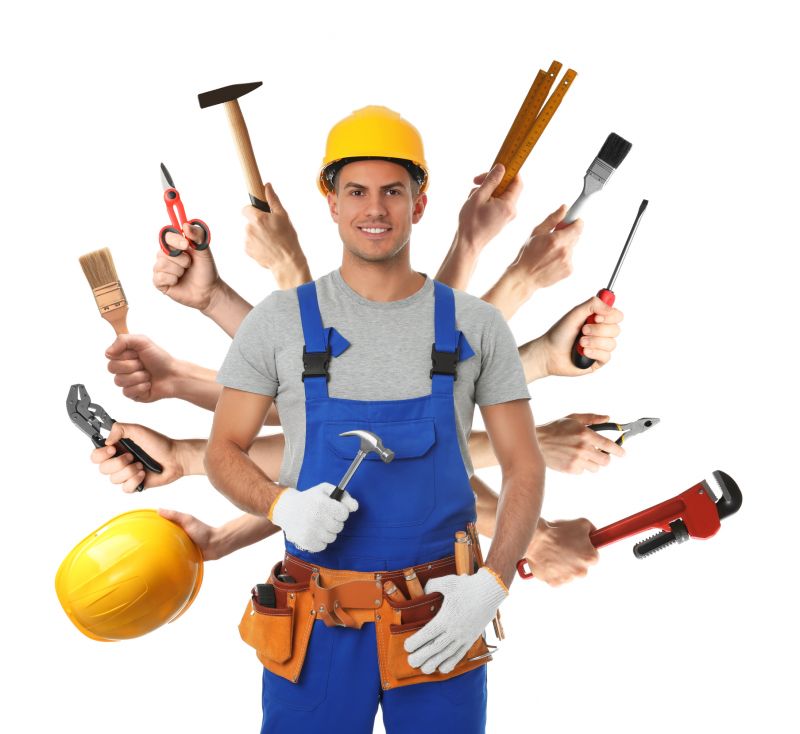Leading Equipment and Tools for Reliable Handyman Service Delivery
Select top-performing products that support efficient, safe, and effective handyman work across diverse tasks.
 A well-equipped set of tools and products is essential for any handyman service to operate efficiently and effectively. From basic hand tools to specialized power equipment, having a comprehensive collection allows service providers to tackle a wide range of repair, maintenance, and renovation tasks. Durability and reliability are key factors when selecting these products, ensuring they can withstand frequent use and challenging job site conditions. Additionally, versatility in product options enables handymen to adapt to various project requirements, whether it's fixing a leaky faucet, installing shelves, or performing electrical repairs.
A well-equipped set of tools and products is essential for any handyman service to operate efficiently and effectively. From basic hand tools to specialized power equipment, having a comprehensive collection allows service providers to tackle a wide range of repair, maintenance, and renovation tasks. Durability and reliability are key factors when selecting these products, ensuring they can withstand frequent use and challenging job site conditions. Additionally, versatility in product options enables handymen to adapt to various project requirements, whether it's fixing a leaky faucet, installing shelves, or performing electrical repairs.
Top Overall Option
Multi-Tool Kit with Cordless Power Tools
A comprehensive multi-tool kit that includes a variety of cordless power tools, such as drills, saws, and sanders, along with a selection of accessories and batteries. This versatile set is designed to handle multiple tasks, from drilling and cutting to sanding and grinding, making it a valuable all-in-one solution for handyman services. Its portability and ease of use help improve workflow and productivity on various job sites.
Types of Products For Handyman Service
Cordless Drill and Impact Driver Sets
Essential for drilling, screwing, and fastening tasks across many projects, offering portability and ease of use.
Hand Tools Set
Includes hammers, screwdrivers, pliers, and wrenches, forming the foundation of any toolkit.
Power Saws
Varieties include circular saws, jigsaws, and reciprocating saws suitable for cutting wood, metal, or plastic.
Measuring and Layout Tools
Tools like tape measures, laser levels, and square rulers ensure precision in projects.
Fastening and Anchoring Supplies
Includes nails, screws, anchors, and adhesives for secure and durable fixtures.
Plumbing Tools
Pipe wrenches, pliers, and leak detectors for plumbing repairs and installations.
Electrical Tools
Multimeters, wire strippers, and voltage testers for electrical work.
Ladders and Scaffolding
Provides access to elevated work areas safely and efficiently.
Safety Equipment
Includes gloves, goggles, ear protection, and masks to ensure safety on-site.
Tool Storage Solutions
Toolboxes, carts, and organizers to keep equipment organized and accessible.
Paint and Surface Preparation Tools
Brushes, rollers, sanders, and scrapers for finishing surfaces.
Clamps and Vises
Hold materials steady during cutting, gluing, or assembly tasks.
Electrical Tape and Insulation Materials
For wiring insulation and electrical repairs.
Sealants and Caulking Guns
Used for sealing gaps, cracks, and joints in various surfaces.
Popular Choices
Widely used for drilling and fastening tasks across many projects.
Versatile for cutting, sanding, and scraping in tight spaces.
Help achieve precise alignment and leveling in construction tasks.
Provide safe access to elevated work areas for various jobs.
Ideal for demolition and cutting tasks in different materials.
Basic hand tools for gripping, turning, and fastening.
Allow efficient application of paint over large surfaces.
Useful for loosening or tightening bolts and nuts quickly.
Illuminate work areas for better visibility during projects.
Facilitate surface finishing and preparation tasks.
Versatile for cutting various materials with precision.
Convenient for quick screw driving and removal.
Assist in locating framing studs behind walls.
Provide power access at different locations on site.
Organizing and maintaining these tools is also a critical aspect of a successful handyman operation. Investing in quality storage solutions, such as tool belts, boxes, and carts, can improve workflow and prevent loss or damage of valuable equipment. Safety gear and accessories are equally important to protect workers during projects, especially when handling power tools, working at heights, or dealing with hazardous materials. Overall, a strategic selection of products tailored to specific tasks can enhance productivity, safety, and the quality of service delivered.
Considering the range of tasks that a handyman service may encounter, selecting products that balance performance, ease of use, and affordability is vital. Whether the job involves carpentry, plumbing, electrical work, or general repairs, having the right tools and supplies on hand can make all the difference. Regular updates and maintenance of equipment ensure consistent performance and longevity, making it worthwhile to invest in high-quality products from reputable sources. By building a versatile and reliable toolkit, handyman professionals can confidently approach diverse projects with efficiency and precision.
Key Buying Considerations
- Determine the specific tasks most frequently encountered to select appropriate tools.
- Prioritize quality and durability to ensure long-term use and safety.
- Consider the power source, such as corded versus cordless, based on mobility needs.
- Evaluate the compatibility of accessories and attachments for versatility.
- Assess safety features and protective gear included or recommended with tools.
- Check for ergonomic design to reduce fatigue during extended use.
- Review the weight and size of tools for ease of handling and storage.
- Look for reputable brands or manufacturers with positive customer feedback.
- Compare warranty and service options for peace of mind and support.
- Consider budget constraints while balancing quality and features.
- Ensure compatibility with existing tools and supplies in your toolkit.
- Verify availability of replacement parts and accessories for maintenance.
- Assess the ease of use and learning curve for new or advanced tools.
- Review storage solutions to keep tools organized and protected.
- Think about future expansion or upgrades to your toolkit as skills grow.
This page contains affiliate links. We may earn a commission when you purchase through these links, at no additional cost to you. This supports our efforts to provide comprehensive and helpful content.
